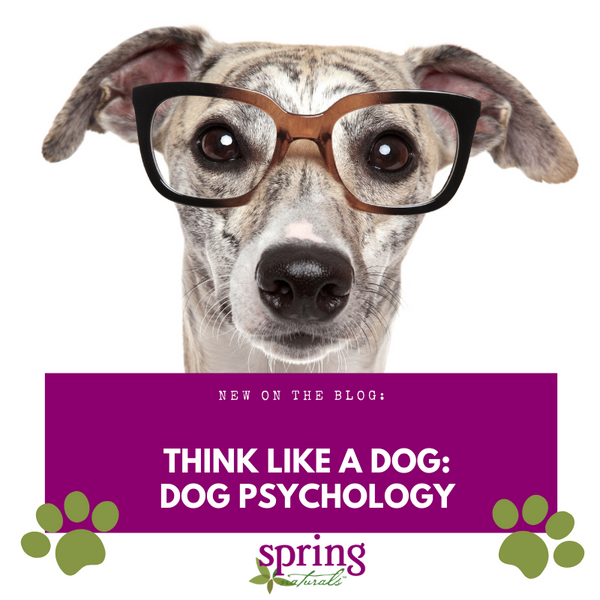
How a Dog’s Mind Really Works: Dog Psychology 101
Wondering what’s going on behind those big puppy dog eyes? Desperate to figure out why your dog is acting out? Maybe you’re trying to be the best dog trainer you can? Join me as I dive into some real research into the truth behind dog psychology, helping us offer our pets the most happy and healthy life we possibly can!
What are Dogs Thinking?
Did you know that people have been studying dog behavior since the 1800s? There have been hundreds of studies done around the world with a variety of pooches for people to understand a dog’s behavior and how their mind works. “Dog psychology” research includes learning how dogs think, social interactions between dogs, and how dogs bond with each other and humans.
But even with tons of scientific research, there is still a lot of conflicting and confusing information about how dogs behave. Animal behaviorists have a lot of perspectives on how dogs think and bond with their owners.
Let’s start with the big picture first. There are three main theories related to dog psychology:
- Schenkel’s pack mentality concepts
- Pavlov’s dog psychology with classical conditioning
- Skinner’s operant conditioning & positive reinforcement
Each theory comes with its own set of pros and cons and practical applications to dog behavior and training. So, let’s dive in!
In 1947 a researcher named Rudolph Schenkel announced the results of a long study he did observing the behavior of wolves in captivity.
Schenkel noticed that groups of captive wolves established a social hierarchy. They competed constantly through aggression to determine a rank of which wolf was leader of the pack. Many other researchers, zoologists, and animal behaviorists have since observed the same social hierarchy. From there, it was only a short leap to think that our pet dogs behave the same way.
So, the earliest dog psychology theories said that:
- Because dogs are genetically related to wolves, their behavior patterns and how they bond with each other are the same.
- Domestic dogs will bond with humans living together in a household in the same way: dogs consider the human members of a household part of their pack.
- Within a human-pet household, a dog owner should establish him- or herself as the ‘alpha’ animal over the dog in order to bond well with their pets and to create harmony in the home.
You may have seen some of these ideas put into practice by television star Cesar Milan. Cesar Milan shows people how to train dogs using his “Natural Laws of Dogs:” that dogs are pack animals and their behaviors are instinctual.
This concept of dog psychology suggests the best way to bond with your pet dog would be to set firm boundaries and limitations that establish yourself as leader of the family pack, as well as to learn how to keep your dog in a “calm, submissive state.” They also believe that the best way to bond properly with your dog is to use intimidating, dominating body language and training techniques.
Does it Work?
Many dog owners have been quite successful establishing firm boundaries with their dogs to correct problematic behavior at home. However, many modern behaviorists and trainers say that there were too many flaws in this original theory and the study from which they were derived.
For example, a wolf behavior expert named David Mech showed through several series of studies that there were problems with the observations from Schenkel and others’ research. Mech said,
“Attempting to apply information about the behavior of assemblages of unrelated captive wolves to the familial structure of natural packs has resulted in considerable confusion. Such an approach is analogous to trying to draw inferences about human family dynamics by studying humans in refugee camps. The concept of the alpha wolf as a ‘top dog’ ruling a group of similar-aged compatriots is particularly misleading.” (Mech, 2000)
So, then let’s move into a different approach to dog psychology that might offer deeper insight.
Theory 2: Pavlov’s Dog Psychology – Classical Conditioning
Have you ever heard of “Pavlov’s dogs experiment?” In the late 1800s, Ivan Pavlov conducted some now-famous research using dogs.
His work demonstrate that dogs can be conditioned to make a firm connection, even subconsciously, between two completely unrelated events together in their mind. Every day before feeding the dogs, Pavlov would ring a buzzer (or metronome, depending on your Russian translation preferences). After just a few days, the dogs would begin salivating at the sound of the buzzer, subconsciously expecting food to come next. Even when food wasn’t present, the dogs would salivate heavily at the sound of a buzzer.
Since then, there have been endless repetitions and variations that support this psychological phenomenon happening with many animals and humans in many different types of situations.
The style of learning is now called “classical conditioning” or “Pavlovian conditioning.” It’s the basis for training dogs and other animals with “clicker training.” (In zoos and even for the military, animals are trained using whistles in the same way!)
Classical conditioning is also the reason dog trainers know that dogs can be conditioned or “trained” to relax comfortably in their bed or crate by using yummy treats and fun toys anytime the dog is in his or her crate.
The technique is even able to be used to “unlearn” something. For example, dogs that have traumatic fear or aggression can be somewhat “retrained” using “counter-conditioning” to re-associate negative triggers with positive experiences/rewards.
Seems easy enough, right? Use treats to train a dog to do whatever you want using reflexive associations? Almost! But of course, there’s a lot more to dog psychology that we know now.
So, let’s explore some other research to reveal deeper levels of dog psychology.
Theory 3: B.F. Skinner’s Operant Conditioning & Positive Reinforcement
In the 1900s, a scientist named B.F. Skinner decided to study dog behavior in a more complex way than had been done previously. His research led to our understanding of something called “operant conditioning.”
Operant conditioning is the idea that an animal (or human) can be “trained” by applying positive or negative stimuli after specific behaviors. The idea is that if there’s always a wonderful reward directly after an animal does something, he’s going to want to do that thing again and again to get more rewards.
And in the opposite contest, if an animal experiences a punishment after doing something, he or she won’t want to do that behavior again! This is the reason so many venomous and poisonous animals and plants have bright coloration – an animal learns that after eating something brightly colored, they get very, very sick! They learn to avoid bright colored prey.
Operant conditioning is applied to dog psychology by understanding that in addition to certain behaviors that are instinctive and subconscious, dogs also have behaviors that they choose to do in order to earn/avoid reward or punishment. Some of the applications of operant conditioning in how we bond with our pets include:
- If we want our dog to act in a certain way, we can reward those behaviors with treats, toys, or affection. For example, let’s say we want our dog to sit for us to put his leash on him. We can train him to do so by giving him a treat every time he sits and repeating the behavior/reward system every time we get the leash out. (Positive reinforcement)
- If we want to discourage our dog from doing certain things, we can remove any reward from the situation. For example, if we don’t want our dog to jump up on us when we’re trying to feed her a meal, we can withhold the food bowl until the dog stops jumping. (Negative punishment)
- If a dog experiences something negative after doing something, he will try to avoid that situation again. Such as if his owner purposefully hits him on the nose with a newspaper when she catches eating out of the garbage can. (Positive punishment)*
- If a dog is experiencing something negative that suddenly goes away after doing a particular behavior, the dog learns to continue to do that behavior in order to prevent the negative stimulus from returning. A traditional way of teaching hunting dogs to retrieve and carry game utilized this concept. A trainer would apply painful pressure to a dog’s ear, then physically insert a dummy game item into the dog’s mouth, then immediately remove the pressure from its ear. The dog would learn that it was best for him to pick up and hold any dummies or game he saw. (Negative reinforcement)*
*We never condone inflicting pain on our pets. Furthermore, there have been recent studies that show that dogs that experience this type of interaction from humans can develop serious behavioral problems and aggression. Therefore, we do not condone these behavior shaping methods.
Behavioral Science isn’t Perfect!
Dog trainers don’t agree on everything yet. And not all psychology theories work perfectly for all dogs. There are some flaws with each of these theories, such as:
- Captive animals and wild animals don’t always act the same.
- Wolves and dogs are not the same animal – we cannot assume that the behavior patterns of dogs mimic those of wolves.
- Domestic dogs and wild dogs have different behavior patterns as well.
- Humans are not dogs, so we cannot assume that dogs view us as members of their ‘pack.’
- We cannot assume that pet dogs act the same as dogs (or other animals) in laboratory settings.
- Even within the domestic dog species, there is a wide range of personality traits and instincts from breed to breed and individual to individual.
- It’s not scientifically reasonable to attribute human behavior traits to any animal, including dogs. It’s called anthropomorphism, and it’s one reason why dog psychology discussions can get so controversial.
Some Things We CAN Agree On!
- Dogs have adapted many behaviors unlike other wild animals as a result of living so closely with humans for so long.
- Dogs have adapted an extremely strong ability to observe and learn from gestures and verbal cues from humans – even more so than primates!
- Dogs are remarkable (relative to other animals) at copying behaviors from each other to learn new tasks.
“It was suspected that dogs are more socially skilled than primates and wolves because they (dogs) are heavily exposed to people throughout their lifetime. In a surprise finding, young puppies with little exposure to humans are as skilled at using human gestures as adult dogs are.” (Kaminsky 2009)
Furthermore, what’s really great overall is that the field of dog psychology has exploded in the past few decades. There have been more studies of domestic dog behavior in the past 20 years than in the past 200 years combined. More and more dog psychology books are added every year. This means that every year, we’ll have more and more access to understanding dog psychology so that we can better serve the health and livelihood of Man’s Best Friend.
References:
Hare, Brian & Vanessa. The Genius of Dogs Published by Plume, 2013.
Schenkel, Rudolph.Expressions Studies on Wolves. 1947. https://archive.org/details/SchenkelCaptiveWolfStudy.compressed/page/n11
Milan, Cesar. Dog Psychology, https://www.cesarsway.com/dog-psychology
Mech, David. Leadership in Wolf, Canis lupus, Packs. Canadian Field Naturalist, 2000.
(https://digitalcommons.unl.edu/usgsnpwrc/384/)
Stillwell, Victoria. “Pack Theory Debunked.” https://positively.com/dog-training/myths-truths/pack-theory-debunked/
Pavlov, Ivan. Conditioned Reflexes: An investigation of the physiological activity of the cerebral cortex. 1927.
Skinner, B. F. "The Behavior of Organisms: An Experimental Analysis", 1938 New York: Appleton-Century-Crofts
Kaminski J. Dogs (Canis familiaris) are Adapted to Receive Human Communication. In: Berthoz A., Christen Y. (eds) Neurobiology of “Umwelt”. Research and Perspectives in Neurosciences. Springer, Berlin, Heidelberg 20-09.

Post a Comment!